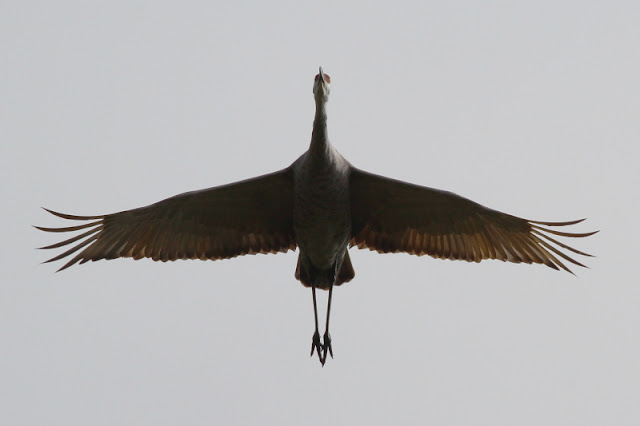Made my way further North from Fort Myers up to St. Petersburg near Tampa. I took a quick look again at Little Estero Lagoon in the hope for Yellow-crowned Night Heron, hoping that they would be more active first thing at dawn but again no sign. More good views of Reddish Egrets. I had a very distant Black Skimmer at least a mile up along the beach. By the time I managed to drive up it was gone but I did have two nice close frigatebirds (no camera) and a flock of about 100 Knots. At least 24 of these were colour ringed, an amazing percentage. Most had been ringed in Florida and a few in South Carolina going back as far as 2006. None have been resighted further North than New Jersey. All had lime green flags.
I still hadn't seen any Red-cockaded Woodpeckers, one of the rarest woodpecker species found in the States. I had already tried at least two reserves of open longleaf pine woodland and only managed a very brief view of a black and white woodpecker. North of Fort Myers at Cecil M. Webb State Wildlife Management Area I managed to connect with a pair which gave good views. The species is intensively managed. The forest floor is burnt every few years to keep it open as would have naturally happened historically. All birds are "banded" and single males are often translocated to area containing single females. The nest trees are marked by white circles at their bases. I also had untickable views of a Bachmanns Sparrow here. This is another speciality of dry pine woodland with saw-palmetto. They can be difficult to pick up when not singing in the Spring time.
I finished up the day around the Celery Fields/Ackerman Park. This was a small area that I nearly picked at random from the guidebook as I happened to be making my way up to Tampa at the time. This was an excellent example of how good some of these smaller lesser well known spots compared to the larger, better known sites. There was an excellent line up of waterbirds here including my best views of Roseate Spoonbill, they had all been a little distant up until this. Some nice views of Lesser Scaup and Ring-necked Duck also but the light conditions made it difficult for photography.
I still hadn't seen any Red-cockaded Woodpeckers, one of the rarest woodpecker species found in the States. I had already tried at least two reserves of open longleaf pine woodland and only managed a very brief view of a black and white woodpecker. North of Fort Myers at Cecil M. Webb State Wildlife Management Area I managed to connect with a pair which gave good views. The species is intensively managed. The forest floor is burnt every few years to keep it open as would have naturally happened historically. All birds are "banded" and single males are often translocated to area containing single females. The nest trees are marked by white circles at their bases. I also had untickable views of a Bachmanns Sparrow here. This is another speciality of dry pine woodland with saw-palmetto. They can be difficult to pick up when not singing in the Spring time.
I finished up the day around the Celery Fields/Ackerman Park. This was a small area that I nearly picked at random from the guidebook as I happened to be making my way up to Tampa at the time. This was an excellent example of how good some of these smaller lesser well known spots compared to the larger, better known sites. There was an excellent line up of waterbirds here including my best views of Roseate Spoonbill, they had all been a little distant up until this. Some nice views of Lesser Scaup and Ring-necked Duck also but the light conditions made it difficult for photography.
 |
| Roseate Spoonbill |
 |
| Roseate Spoonbill |
 |
| Roseate Spoonbill, only noticed the ring on the left hand bird on reviewing the shots, can't make out the code though. |
 |
| Roseate Spoonbill |
 |
| Roseate Spoonbill |
 |
| White Ibis |
 |
| First-winter Tricolored Heron |
 |
| Snowy Egret |
 |
| Adult Tricolored Heron |
 |
| Little Blue Heron |
 |
| White morph Reddish Egret |
 |
| White morph Reddish Egret |
 |
| White and red morph Reddish Egrets |
 |
| Red morph Reddish Egret |
 |
| Red morph Reddish Egret with a tocuh of white |
 |
| American Bittern, taken in near darkness with a shutter speed of 0.8 seconds. |
 |
| Double-crested Cormorant |
 |
| Brown Pelican |
 |
| American Oystercatcher |
 |
| Western Willet |
 |
| Greater Yellowlegs |
 |
| Greater Yellowlegs |
 |
| Knot |
 |
| Knot |
 |
| Magnificent Frigatebird |
 |
| Red-cockaded Woodpecker |
 |
| Red-cockaded Woodpecker |
 |
| Red-cockaded Woodpecker hole with someone at home. |
 |
| Red-cockaded Woodpecker habitat |
 |
| Sandhill Crane |
 |
| House Wren |
 |
| Fish Crow |
 |
| Lesser Scaup and Ring-necked Ducks |
 |
| Cooper's Hawk |
Cracking array of shots and birds there Dermot.
ReplyDeleteHave you submitted the red knot flag reports to www.bandedbirds.org? I know they’d appreciate it, and they can tell you when the birds were banded and where they were sighted previously (lime flag tells me they were banded in NJ). Thanks!
ReplyDeleteHi "60d0e1b0-55a8-11e2-9988-000bcdcb471e"
DeleteYes I have already submitted these records. Most were ringed in Florida with a few in South Carolina and New Jersey which is why mentioned this in the posting above? The bandedbirds.org website is a fantastic site. Much better than our equivalent BTO one.